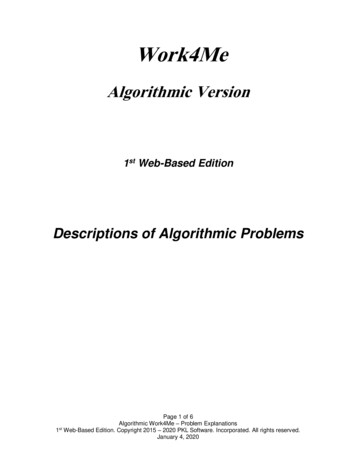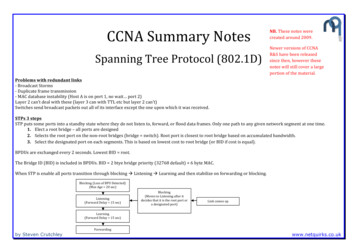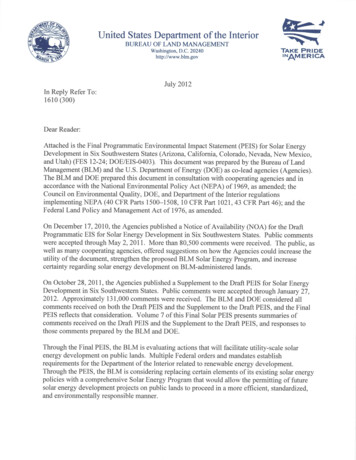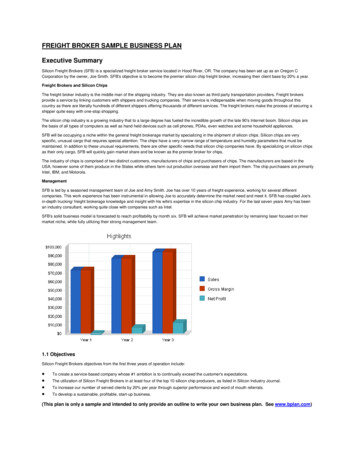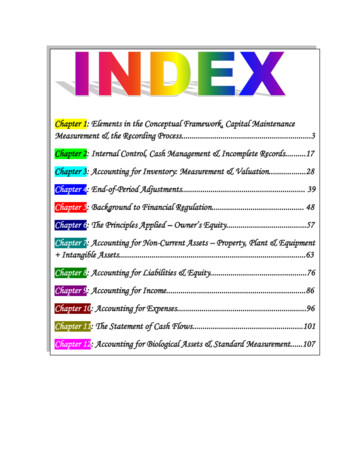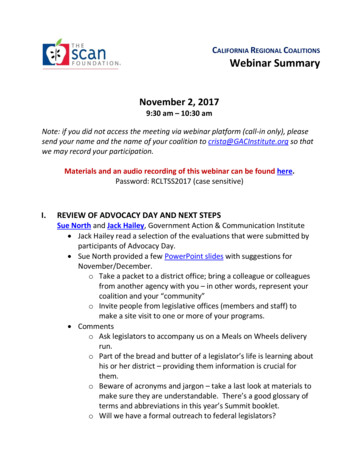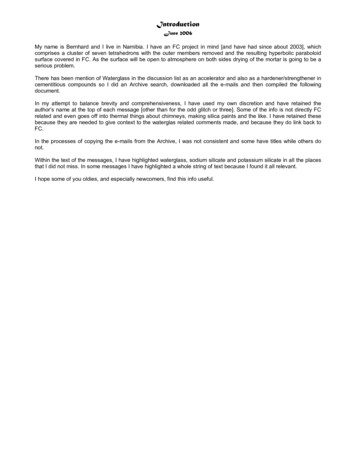
Transcription
LAB SIMULATIONSSUMMARYLAB 1 - 30CA S.S. -----http://www.physicsinmotion.comLAB 1.1 ORDERS OF MAGNITUDENone for this lab assignment.LAB 2.1 MEASURING TIME Learn about position, velocity, and acceleration graphs. Move the little man back and forth with themouse and plot his motion. Set the position, velocity, or acceleration and let the simulation movethe man for you.LAB 2.2 ACCELERATION OF A CART http://physics.bu.edu/ duffy/HTML5/motion diagrams.htmlhttp://physics.bu.edu/ duffy/HTML5/1Dmotion constantv constanta.htmlLAB 3.1 GRAVITATIONAL ACCELERATION OF A PROJECTILE /physics.bu.edu/ duffy/HTML5/constant acceleration.htmlhttp://physics.bu.edu/ duffy/HTML5/2Dmotion race.htmlhttp://physics.bu.edu/ duffy/HTML5/ballistics cart.htmlhttp://physics.bu.edu/ duffy/HTML5/projectile2.htmlhttp://physics.bu.edu/ duffy/HTML5/projectile motion.htmlhttp://physics.bu.edu/ duffy/HTML5/monkey hunter.htmlhttp://physics.bu.edu/ duffy/HTML5/constant acceleration lab.htmlLAB 4.1 MOTION AND FORCE -motionExplore the forces at work when you try to push a filing cabinet. Create an applied force and seethe resulting friction force and total force acting on the cabinet. Charts show the forces, position,velocity, and acceleration vs. time. View a Free Body Diagram of all the forces (includinggravitational and normal forces). -motion-basicsExplore the forces at work in a tug of war or pushing a refrigerator, crate, or person. Create anapplied force and see how it makes objects move. Change friction and see how it affects themotion of objects. xplore the forces at work when you try to push a filing cabinet. Create an applied force and seethe resulting friction force and total force acting on the cabinet. Charts show the forces, position,velocity, and acceleration vs. time. View a Free Body Diagram of all the forces (includinggravitational and normal forces).PHYSICSINMOTION
http://physics.bu.edu/ duffy/HTML5/Atwoods machine.htmlLAB 4.2 COEFFICIENT OF SLIDING FRICTION arn how friction causes a material to heat up and melt. Rub two objects together and they heatup. When one reaches the melting temperature, particles break free as the material melts away. http://mrmaloney.com/mr maloney/simulations/sims.htmlGo to Mass Hanging Over Table Edge (mem2.) Set up several parameters, record theresults and compare these results with the equations from the textbook CH-4.LAB 5.1 UNIFORM CIRCULAR MOTION rce-labVisualize the gravitational force that two objects exert on each other. Change properties of theobjects in order to see how it changes the gravity force. d-orbitsMove the sun, earth, moon and space station to see how it affects their gravitational forces andorbital paths. Visualize the sizes and distances between different heavenly bodies, and turn offgravity to see what would happen without it!LAB 6.1 WORK RELATIONSHIP IN THE INCLINED PLANE plore forces, energy and work as you push household objects up and down a ramp. Lower andraise the ramp to see how the angle of inclination affects the parallel forces acting on the file cabinet.Graphs show forces, energy and work. s-and-motionExplore forces and motion as you push household objects up and down a ramp. Lower and raise theramp to see how the angle of inclination affects the parallel forces. Graphs show forces, energy andwork.LAB 6.2 CONSERVATION OF ENERGY te-parkLearn about conservation of energy with a skater dude! Build tracks, ramps and jumps for the skaterand view the kinetic energy, potential energy and friction as he moves. You can also take the skaterto different planets or even space! te-park-basicsLearn about conservation of energy with a skater dude! Explore different tracks and view the kineticenergy, potential energy and friction as he moves. Build your own tracks, ramps and jumps for theskater.LAB 7.1 MOMENTUM AND RELATION TO FORCE http://mrmaloney.com/mr maloney/simulations/sims.htmlGo to one D collision (mem2). Change the variables, create a data table and record thegraphs.PHYSICSINMOTION
LAB 7.2 COLLISION AND IMPULSE labUse an air hockey table to investigate simple collisions in 1D and more complex collisions in 2D.Experiment with the number of discs, masses, and initial conditions. Vary the elasticity and see howthe total momentum and kinetic energy changes during collisions. http://physics.bu.edu/ duffy/HTML5/collisions 1D.html http://physics.bu.edu/ duffy/HTML5/ramps.htmlLAB 8.1 TORQUE AND FORCES ON A BEAM in the ladybug in an exploration of rotational motion. Rotate the merry-go-round to change its angle,or choose a constant angular velocity or angular acceleration. Explore how circular motion relates tothe bug's x,y position, velocity, and acceleration using vectors or graphs. actPlay with objects on a teeter totter to learn about balance. Test what you've learned by trying theBalance Challenge game.LAB 10.1 FLUIDS nd-buoyancyExperiment with a helium balloon, a hot air balloon, or a rigid sphere filled with different gases.Discover what makes some balloons float and others sink. en will objects float and when will they sink? Learn how buoyancy works with blocks. Arrows showthe applied forces, and you can modify the properties of the blocks and the fluid. sure-and-flowExplore pressure in the atmosphere and underwater. Reshape a pipe to see how it changes fluid flowspeed. Experiment with a leaky water tower to see how the height and water level determine thewater trajectory. http://physics.bu.edu/ duffy/HTML5/ball in viscous fluid.htmlLAB 11.1 SIMPLE HARMONIC MOTION – SPIRAL SPRING esPlay with a 1D or 2D system of coupled mass-spring oscillators. Vary the number of masses, set theinitial conditions, and watch the system evolve. See the spectrum of normal modes for arbitrarymotion. See longitudinal or transverse modes in the 1D system. g-labA realistic mass and spring laboratory. Hang masses from springs and adjust the spring stiffness anddamping. You can even slow time. Transport the lab to different planets. A chart shows the kinetic,potential, and thermal energy for each spring. rn how to make waves of all different shapes by adding up sines or cosines. Make waves in spaceand time and measure their wavelengths and periods. See how changing the amplitudes of differentharmonics changes the waves. Compare different mathematical expressions for your waves.PHYSICSINMOTION
LAB 11.2 SIMPLE HARMONIC MOTION – PENDULUM um-lab en.htmlPendulumPlay with one or two pendulums and discover how the period of a simple pendulum depends on thelength of the string, the mass of the pendulum bob, and the amplitude of the swing. It's easy tomeasure the period using the photogate timer. You can vary friction and the strength of gravity. Usethe pendulum to find the value of g on planet X. Notice the harmonic behavior at large amplitude. http://physics.bu.edu/ duffy/HTML5/pendulum.htmlLAB 12.1 SPEED OF SOUND IN AIR https://phet.colorado.edu/en/simulation/soundThis simulation lets you see sound waves. Adjust the frequency or volume and you can see and hearhow the wave changes. Move the listener around and hear what she hears. http://physics.bu.edu/ duffy/HTML5/speed of sound.htmlLAB 13.1 BOYLE’S LAW tiesPump gas molecules to a box and see what happens as you change the volume, add or remove heat,change gravity, and more. Measure the temperature and pressure, and discover how the propertiesof the gas vary in relation to each other. les-law.htmlThis lab includes a worksheet which must be completed. o to the link for Boyle’s law and complete the activity. This will include the graph provided.LAB 14.1 THERMAL CAPACITY AND SPECIFIC HEATNone for this lab assignment.LAB 16.1 ELECTRIC CHARGE AND ELECTRIC FIELD http://physics.bu.edu/ duffy/HTML5/puzzle Coulomb.htmlLAB 17.1 ELECTRICAL POTENTIAL labExplore how a capacitor works! Change the size of the plates and add a dielectric to see how itaffects capacitance. Change the voltage and see charges built up on the plates. Shows the electricfield in the capacitor. Measure voltage and electric field. d-fieldsMove point charges around on the playing field and then view the electric field, voltages, equipotentiallines, and more.LAB 18.1 OHM’S LAW AND RESISTANCE -in-a-wireLearn about the physics of resistance in a wire. Change its resistivity, length, and area to see howthey affect the wire's resistance. The sizes of the symbols in the equation change along with thediagram of a wire.PHYSICSINMOTION
LAB 19.1 BUILDING CIRCUITS – SERIES AND PARALLEL nstruction-kit-acThis new version of the CCK adds capacitors, inductors and AC voltage sources to your toolbox! Nowyou can graph the current and voltage as a function of time. nstruction-kit-ac-virtual-labBuild circuits with capacitors, inductors, resistors and AC or DC voltage sources, and inspect themusing lab instruments such as voltmeters and ammeters. nstruction-kit-dcAn electronics kit in your computer! Build circuits with resistors, light bulbs, batteries, and switches.Take measurements with the realistic ammeter and voltmeter. View the circuit as a schematicdiagram, or switch to a life-like view. nstruction-kit-dc-virtual-labBuild circuits with resistors, light bulbs, batteries, and switches and take measurements withlaboratory equipment like the realistic ammeter and voltmeter.LAB 20.1 MAPPING MAGNETIC FIELDSNone at this timeLAB 20.2 STRENGTH OF A MAGNETIC FIELDNone at this timeLAB 21.1 ELECTROMAGNETIC INDUCTION and FARADAY’S LAW y with a bar magnet and coils to learn about Faraday's law. Move a bar magnet near one or twocoils to make a light bulb glow. View the magnetic field lines. A meter shows the direction andmagnitude of the current. View the magnetic field lines or use a meter to show the direction andmagnitude of the current. You can also play with electromagnets, generators and transformers! awLight a light bulb by waving a magnet. This demonstration of Faraday's Law shows you how to reduceyour power bill at the expense of your grocery bill.LAB 23.1 PLANE MIRRORS AND THE LAW OF REFLECTION http://physics.bu.edu/ duffy/HTML5/Mirrors.htmlLAB 23.2 FORMATION OF IMAGES BY SPHERICAL MIRRORS http://physics.bu.edu/ duffy/HTML5/Mirrors.htmlLAB 23.3 CONVEX LENSES ghtExplore bending of light between two media with different indices of refraction. See how changingfrom air to water to glass changes the bending angle. Play with prisms of different shapes and makerainbows.PHYSICSINMOTION
http://physics.bu.edu/ duffy/HTML5/Lenses.htmlLAB 24.1 DIFFRACTION GRATINGS spectrumHow does the blackbody spectrum of the sun compare to visible light? Learn about the blackbodyspectrum of the sun, a light bulb, an oven, and the earth. Adjust the temperature to see the wavelengthand intensity of the spectrum change. View the color of the peak of the spectral curve. http://physics.bu.edu/ duffy/HTML5/double slit.htmlLAB 30.1 RADIOACTIVE DECAY yWatch alpha particles escape from a polonium nucleus, causing radioactive alpha decay. See howrandom decay times relate to the half life. Watch beta decay occur for a collection of nuclei or for an individual nucleus. http://mrmaloney.com/mr maloney/simulations/sims.htmlGo to Random Coin Flipping (compare). Change the amount of coins and collect the graphsgenerated.PHYSICSINMOTION
PHYSICSINMOTION LAB 7.2 COLLISION AND IMPULSE lab Use an air hockey table to investigate simple collisions in 1D and .
